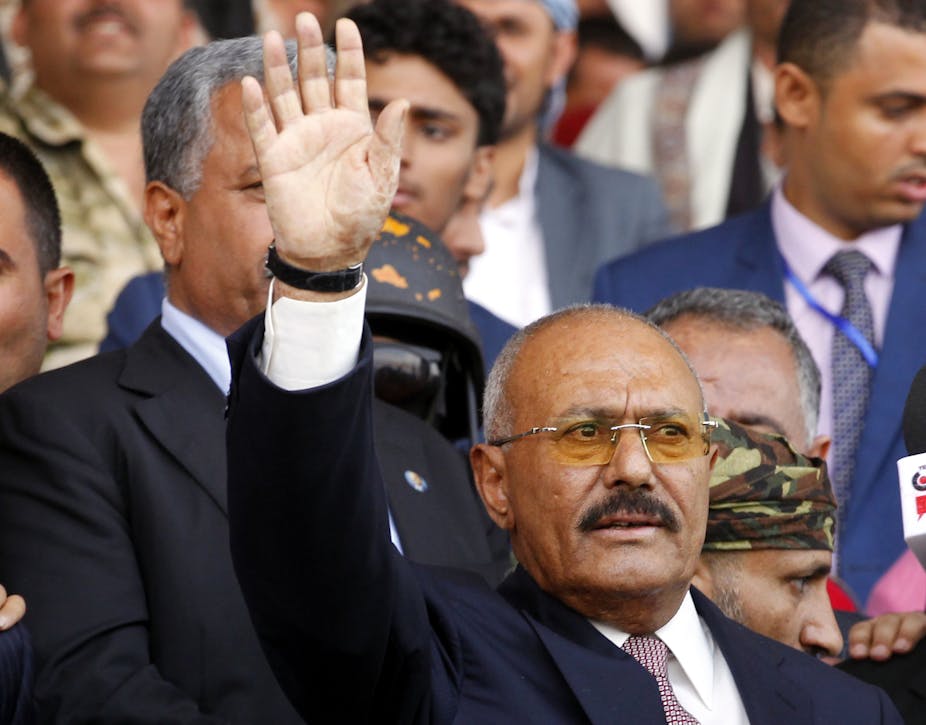Ali Abdullah Saleh, the former president of Yemen who was killed in fighting in early December in the capital Sana'a, was a lynch pin in the complex twists and turns of the coups, revolutions and nation-building of the country’s recent history. Saleh’s violent ending – likely at the hands of the Houthi rebels he once fought, then fought with, and then betrayed – reverberates loudly across Yemen and the wider region.
Born in Sana’a in 1942, Saleh joined the army that led a 1962 coup against Yemeni Imamate rule, until that time the seat of power in North Yemen. After rising through the army ranks to major general, Saleh was elected president of the Yemen Arab Republic (North Yemen) in 1978, centred in Sana’a.
When the British pulled out of Aden, in Southern Yemen, in 1967, the Peoples’ Democratic Republic of Yemen (PDRY) was created, led by the Yemeni Socialist Party with Qahtan Mohammed Al-Shaabi as its inaugural president. The PDRY was the first time socialists gained and maintained power in the Arab world.
For more than two decades Yemen was made up of two republics with two separate governments and armies: one in the north and one in the south. Perhaps one of Saleh’s most important accomplishments was his role in the formal reunification of North and South Yemen in 1990 – an achievement which mostly held until the conflict with the Houthi community in the north began in 2004.
Development expert Marta Colburn’s study of development challenges for the 21st century provides useful insight to the immediate challenges for the new unified republic: in 1990 Yemen cast its “most expensive vote” at the UN when it rejected the UN Security Council resolution 678 to counter Iraqi president Saddam Hussein’s invasion of Kuwait. Saleh’s close alliance with Hussein cost the country dearly – the US drastically reduced its aid and the Gulf countries halted aid and sent Yemeni workers back home in their thousands.
When Yemen knocked on the door of the IMF and World Bank in 1995 the response was the bitter pill of a structural adjustment program which required the Yemeni government to cut fuel and basic food subsidies. Although there were some economic gains, Saleh failed to sustain and share the fruits of progress with ordinary Yemeni citizens and he punished the south for its socialist and secessionist stances.
After 9/11 – and with a growing al-Qaida presence in Yemen – Saleh began to align more closely with the US, enabling it to conduct a drone warfare campaign. This targeting of populated villages and towns inevitably meant civilians would perish in the “collateral damage” of war. Meanwhile, Saleh and his network of patronage enriched themselves through increased flows of military and non-military aid.
When the Yemeni people rose up in the Arab spring in 2011, their demands for dignity were an ultimate rejection of Saleh’s rule. He stubbornly refused to cede power even as his support fell away in the face of a brutal crackdown on protests. Eventually extricated from the presidency, Saleh formally handed over to his deputy Abdrabbuh Mansour Hadi in 2012. Saleh then got to work with his enemies, the Houthis in the north of Yemen, to undermine Hadi’s rule – eventually forcing Hadi into exile in Saudi Arabia as the Houthi rebels swept across Yemen from the north. Hadi remains in Riyadh.
Read more: How the Arab sprng led to an increasingly vicious civil war in Yemen
Just before his death, Saleh shifted to support the Saudi-led coalition against the Houthis. It was likely to have been some time in the planning. On November 2, Saleh made gestures towards Saudi Arabia and was widely reported to have called for an uprising against the Houthis. Saleh flipped sides in a desperate attempt to secure his own place at the table – with a devastating cost to the Yemeni people who must now suffer the further intensification of fighting.
A fragmented people
The good will of the Yemeni people has been sorely tested. At the heart of the conflict in Yemen has been a struggle over finite resources – Yemeni oil production accounts for a large part of government revenue but its supplies are near exhaustion and the conflict has interrupted production. Since the uprising there has been a thriving black market for fuel. But the twisted logic of a war economy only brings more suffering to the Yemeni people.
It is not clear that the Yemeni population holds either of the warring factions in very high regard. The record of the Houthis on governance has been mixed – they are fighters not administrators. Under Saleh, vital Yemeni civil society activists were rounded up as punishment for participating in the revolution.

The fear for Yemen now after Saleh’s death is that the public will become increasingly fragmented. The Saudi crown prince has a continuing green light to pursue his ruinous aerial bombardment in pursuit of Houthi fighters on the ground. Iran is likely to offer more support to the Houthis in response.
Meanwhile, Yemen is in the grip of a humanitarian catastrophe with the Famine Early Warning Systems Network warning of famine unless commercial goods are allowed through the country’s ports. Yemen has already witnessed what has been called the biggest cholera outbreak in recent history.
Some might start to voice a desire for a “nostalgic” return to the days of Saleh’s authoritarian, secure but oppressive hold over power. But the time for “dancing on the heads of snakes” as Saleh once described his job, is over. Yemen needs a new politics and the Yemeni people must be allowed to make their own future.

